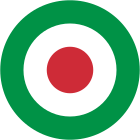| Military Aviation Corps | |
|---|---|
| Corpo Aeronautico Militare | |
  | |
| Active | 1915–1923 |
| Disbanded | 1923 |
| Country | |
| Allegiance | Victor Emmanuel III |
| Branch | |
| Role | Air Force |
| Size | 20,000 aircraft produced |
| Engagements | World War I |
| Commanders | |
| Notable commanders | Maurizio Moris |
| Aircraft flown | |
| Attack | SPAD S.VII SPAD S.XIII (91ª Squadriglia) Nieuport 11(Macchi) Nieuport 17 Hanriot HD.1(Macchi) |
| Bomber | Caproni Ca.1 |
| Patrol | Macchi M.5 |
| Reconnaissance | Ansaldo SVA Pomilio PE |
The Italian Corpo Aeronautico Militare (Military Aviation Corps) was formed as part of the Regio Esercito (Royal Army) on 7 January 1915, incorporating the Aviators Flights Battalion (airplanes), the Specialists Battalion (airships) and the Ballonists Battalion. Prior to World War I, Italy had pioneered military aviation in the Italo-Turkish War during 1911–1912. Its army also contained one of the world's foremost theorists about the future of military aviation, Giulio Douhet; Douhet also had a practical side, as he was largely responsible for the development of Italy's Caproni bombers starting in 1913. Italy also had the advantage of a delayed entry into World War I, not starting the fight until 24 May 1915, but took no advantage of it so far as aviation was concerned.
Italy entered World War I with an air force technologically comparable to a force on the Western Front in 1914. Lacking fighter aircraft, throughout the war the Italians resorted to airplanes supplied by the French either directly or built under license. The early air force was also woefully tactically deficient; basically, its fighter craft were scrambled into the air only when enemy planes were spotted overhead. However, the Caproni bombers developed to operational status, flying their first sorties on 20 August 1915.
After the war the Corpo Aeronautico Militare became the basis of the Regia Aeronautica, which became an air force independent of the Royal Italian Army on 28 March 1923.